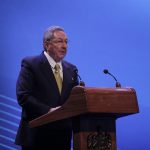It is a body with constitutional and legislative power in the Republic of Cuba. It is made up of deputies elected by the free, direct and secret vote of the electors, in proportion and according to the procedure determined by law.
Revolutionary Government
The institutionalization of the Revolution began at the very moment when the whole system of the pseudo republic was disrupted, even though the revolutionary government performed functions with some provisionally degree during its first 15 years of existence.
As Fidel Castro explained at the First Party Congress:
“The Revolution did not hasten to provide definitive state forms for the country. It was not simply a matter of covering a record, but of creating solid, well thought-out and enduring institutions that responded to the realities of the country.”
These years (1959 to 1975) were characterized by profound, radical and accelerated revolutionary changes, where successive and increasingly violent aggressions by imperialism and internal counterrevolution were also necessary.
In order to deal with the current situation, it was necessary to have an agile, operative and efficient state apparatus, which would represent the working people and be able to make rapid decisions without delay.
The revolutionary government, by concentrating on its legislative, executive and administrative powers, adequately fulfilled its functions throughout the first phase of struggle for survival: it dictated revolutionary laws, expropriated exploiters, developed basic social mutations, carried out successfully the political struggle against external and internal aggressions, supported massively by the people, the revolutionary government promoted in this period vast and profound political, economic, social and cultural transformations in Cuban life.
Popular Power
In 1974, the government decided to carry out an experiment in the province of Matanzas, in the west of the Island, on the establishment of the People’s Power Bodies in the localities.
The objective of this experience was to confirm a series of criteria related to methodological forms for the better functioning of state representative institutions, as well as demographic, territorial issues and, among other relationships, administrative and business relations.
From the beginning of its application, the participation of the citizens in the tasks of local government and in the control of the administration was appreciated, as well as in the search for solutions to the problems that most affected the community.
The fruits of that experience were materialized in the decisions taken to establish the entire system of representative state institutions that culminated in the creation of the People’s Power Bodies in the 169 municipalities and the 14 provinces in which the country is divided.
On October 10 and 17, 1976, on the first and second rounds of elections, 95.2% of all Cubans over the age of 16, by secret ballot and direct ballot, elected more than 30,000 10 725 delegates (councilmen) to the 169 municipal assemblies of the Popular Power (city councils).
Subsequently, with the constitution of the National Assembly of People’s Power on December 2, 1976, the election of the Council of State, its President and Vice-Presidents, and the appointment of the Council of Ministers strengthened the democratic essence of the Revolution with more effective forms of participation in public life, which made possible a more direct intervention of the citizens in the direction of the affairs of the state and of all the activities of the society.

Redacción Digital
Equipo de redactores del sitio web de Radio Mayabeque


